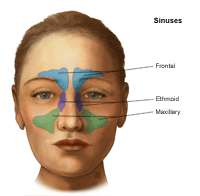Anatomy and Physiology of the Nose and Throat
Anatomy and Physiology of the Nose and Throat
What is the nose?
The nose is the organ of smell located in the middle of the face. The internal part of the nose lies above the roof of the mouth. The nose consists of:
External meatus. Triangular-shaped projection in the center of the face.
External nostrils. Two chambers divided by the septum.
Septum. Made up primarily of cartilage and bone and covered by mucous membranes. The cartilage also gives shape and support to the outer part of the nose.
Nasal passages. Passages that are lined with mucous membranes and tiny hairs (cilia) that help to filter the air.
Sinuses. Four pairs of air-filled cavities, also lined with mucous membranes.
What are sinuses?
The sinuses are cavities, or air-filled pockets, near the nasal passage. As in the nasal passage, the sinuses are lined with mucous membranes. There are 4 different types of sinuses:
Ethmoid sinus. This sinus is located inside the face, around the area of the bridge of the nose. It is present at birth, and continues to grow.
Maxillary sinus. This sinus is located inside the face, around the area of the cheeks. It is also present at birth, and continues to grow.
Frontal sinus. This sinus is located inside the face, in the area of the forehead. It does not develop until around 7 years of age.
Sphenoid sinus. This sinus is located deep in the face, behind the nose. It does not typically develop until adolescence.
What is the throat?
The throat is a ring-like muscular tube that acts as the passageway for air, food, and liquid. The throat also helps in forming speech. The throat consists of:
Larynx (also known as the voice box). The larynx is a cylindrical grouping of cartilage, muscles, and soft tissue that contains the vocal cords. The vocal cords are the upper opening into the windpipe (trachea), the passageway to the lungs.
Epiglottis. A flap of soft tissue located just above the vocal cords. The epiglottis folds down over the vocal cords to prevent food and irritants from entering the lungs.
Tonsils and adenoids. They are made up of lymph tissue and are located at the back and the sides of the mouth. They protect against infection, but generally have little purpose beyond childhood.
Updated:
March 21, 2017
Sources:
Etiologies of nasal symptoms: An overview, Up To Date, Pediatric Physical Examination: An Illustrated Handbook. Duderstadt, K. 2006, ed. 1, unit 2, ch. 13.
Reviewed By:
Fraser, Marianne, MSN, RN,Kacker, Ashutosh, MD

